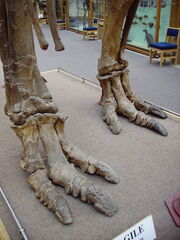| Ornithopods Fossil range: Early Jurassic - Late Cretaceous | |
|---|---|
 Various ornithopod dinosaurs. Far left: Camptosaurus, left: Iguanodon, centre background: Shantungosaurus, center foreground: Dryosaurus, right: Corythosaurus, far right (small): Heterodontosaurus, far right (large): Tenontosaurus. | |
| Scientific classification
| |
| |

Ornithopod heads.

Three-toed Iguanodon feet
Ornithopods are a group of bird-hipped dinosaurs that started out as small, bipedal running grazers, and grew in size and numbers until they became one of the most successful groups of herbivores in the Cretaceous world, and dominated the North American landscape. Their major evolutionary advantage was the progressive development of a chewing apparatus that became the most sophisticated ever developed by a reptile, rivaling that of modern mammals like the domestic cow. They reached their apex in the duck-bills, before they were wiped out by the Cretaceous-Tertiary extinction event along with all other non-avian dinosaurs. Members are known from all seven continents, although the Antarctic remains are unnamed, and they are generally rare in the Southern Hemisphere.
Ornithopoda means "bird feet", from the Greek ornis ("bird") and pous ("feet"); this refers to their characteristic three-toed feet, although many early forms retained four toes. They were also characterized by having no armor, the development of a horny beak, an elongated pubis that eventually extended past the ilium, and a missing hole in the lower jaw. A variety of ornithopods and related cerapods had thin cartilaginous plates along the outside of the ribs; in some cases, these plates mineralized and were fossilized. The function of these intercostal plates is unknown. They have been found with Hypsilophodon, Othnielosaurus, Parksosaurus, Talenkauen, Thescelosaurus,[1] and Macrogryphosaurus to date.[2]
The early ornithopods were only about 1 meter (3 feet) long, but probably very fast. They had a stiff tail, like the theropods, to help them balance as they ran on their hind legs. Later ornithopods became more adapted to grazing on all fours; their spines curved, and came to resemble the spines of modern ground-feeders like the bison. As they became more adapted to eating while bent over, they became semi-quadrupedal; still running on two legs, and comfortable reaching up into trees; but spending most of their time walking or grazing while on all fours. The taxonomy of dinosaurs previously ascribed to the hypsilophodontidae is problematic. The group previously consisted of all non-Iguanodontid bipedal ornithischians, but a phylogenetic reappraisal has shown such species to be paraphyletic. As such, the hypsolophodont family is represented only by Hypsilophodon[3].
Later ornithopods became larger, but never rivaled the incredible size of the long-necked, long-tailed sauropods that they partially supplanted; the largest, like the Edmontosaurus and Shantungosaurus, never grew far beyond 15 meters (50 feet).
Historically, most indeterminate ornithischian bipeds were lumped in as ornithopods. Most have since been reclassified as basal members of quadrupedal taxa like Marginocephalia; and some, like the "bone-headed" pachycephalosaurids, have been given their own taxa.
Classification[]
Taxonomy[]
Infraorder Ornithopoda
- Anabisetia
- Bihariosaurus
- Changchunsaurus
- Fukuisaurus
- Jeholosaurus
- Lurdusaurus
- Muttaburrasaurus
- Siluosaurus
- Talenkauen
- Tenontosaurus
- Family Camptosauridae
- Family Dryosauridae
- Family Hypsilophodontidae*
- Family Iguanodontidae
- Family Rhabdodontidae
- Superfamily Hadrosauroidea
References[]
- ^ Butler, Richard J.; and Galton, Peter M. (2008). "The 'dermal armour' of the ornithopod dinosaur Hypsilophodon from the Wealden (Early Cretaceous: Barremian) of the Isle of Wight: a reappraisal". Cretaceous Research 29 (4): 636-642. doi:.
- ^ Calvo, J.O.; Porfiri, J.D.; and Novas, F.E. (2007). "Discovery of a new ornithopod dinosaur from the Portezuelo Formation (Upper Cretaceous), Neuquén, Patagonia, Argentina.". Arquivos do Museu Nacional 65 (4): 471–483.
- ^ Weishampel, D.B., and Heinrich, R.E. (1992). "Systematics of Hypsilophodontidae and basal Iguanodontia (Dinosauria: Ornithopoda)". Historical Biology 6: 159–184.
External links[]
- Ornithopoda, by Justin Tweet, from Thescelosaurus!
- GEOL 104 dinosaurs: a Natural history, ornithopoda: beaks, bills & crests, by Thomas R. Holtz, Jr.